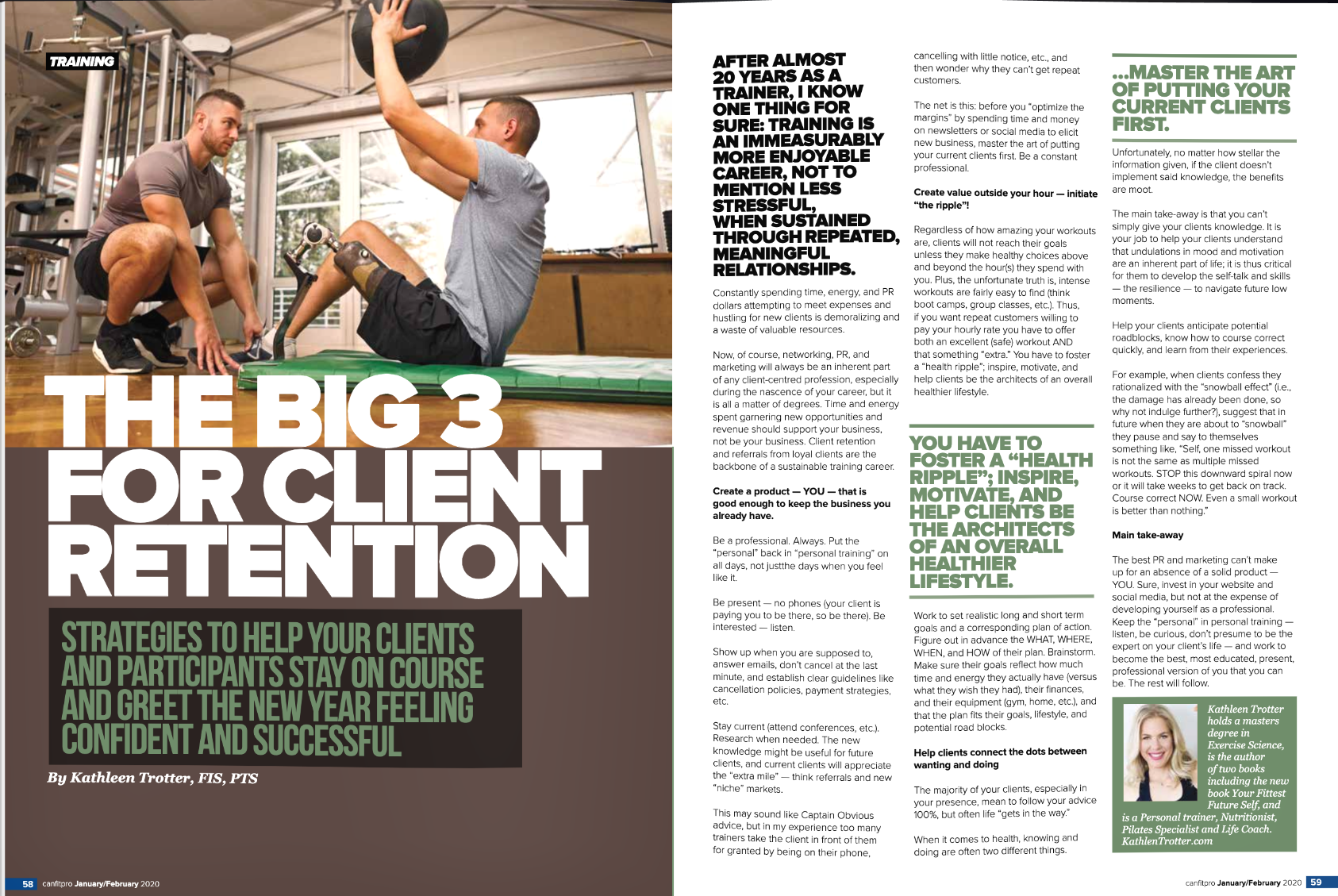The Big 3 for Client Retention

After almost 20 years as a trainer I know one thing for sure: training is an immeasurably more enjoyable — not to mention less stressful — career when sustained through repeat, meaningful relationships.
Constantly spending time, energy, and PR dollars attempting to meet expenses and hustling for new clients is demoralizing and a waste of valuable resources.
Now, of course, networking, PR, and marketing will always be an inherent part of any client-centred profession — especially during the nascence of your career — but it is all a matter of degrees. Time and energy spent garnering new opportunities and revenue should support your business, not be your business. Client retention — and referrals from loyal clients — are the backbone of a sustainable training career.
Create a product — YOU — that is good enough to keep the business you already have
Be a professional. Always. Put the “personal” back in “personal training” — on all days, not just
the days when you feel like it.
Be present — no phones (your client is paying you to be there, so be there). Be interested — listen.
Show up when you are supposed to, answer emails, don’t cancel at the last minute, and establish clear guidelines — cancelation policies, payment strategies, etc.
Stay current (attend conferences, etc.). Research when needed. The new knowledge might be useful for future clients, and current clients will appreciate the “extra mile” — think referrals and new “niche” markets.
This may sound like Captain Obvious advice, but in my experience too many trainers take the client in front of them for granted — by being on their phone, cancelling with little notice, etc. — then wonder why they can’t get repeat customers.
The net is this: before you “optimize the margins” by spending time and money on newsletters or social media to elicit new business, master the art of putting your current clients first. Be a constant professional.
Create value outside your hour — initiate “the ripple”!
Regardless of how amazing your workouts are, clients will not reach their goals unless they make healthy choices above and beyond the hour(s) they spend with you. Plus, the unfortunate truth is, intense workouts are fairly easy to find — think boot camps, group classes, etc. Thus, if you want repeat customers willing to pay your hourly rate, you have to offer both an excellent (safe) workout AND that something “extra.” You have to foster a “health ripple”; inspire, motivate, and help clients be the architects of an overall healthier lifestyle.
Work to set realistic long- and short-term goals and a corresponding plan of action. Figure out in advance the WHAT, WHERE, WHEN, and HOW of their plan. Brainstorm. Make sure their goals reflect how much time and energy they actually have (vs what they wish they had), their finances, and their equipment (gym, home, etc.), and that the plan fits their goals, lifestyle, and potential road blocks.
Help clients connect the dots between wanting and doing!
The majority of your clients — especially in your presence — 100% mean to follow your advice; but often life “gets in the way.”
When it comes to health, knowing and doing are often two different things. Unfortunately, no matter how stellar the information given, if the client doesn’t implement said knowledge, the benefits are moot.
The main take-away is that you can’t simply give your clients knowledge. It is your job to help your clients understand that undulations in mood and motivation are an inherent part of life; it is thus critical for them to develop the self-talk and skills — the resilience — to navigate future low moments.
Help your clients anticipate potential roadblocks, know how to course correct quickly, and learn from their experiences.
For example, when clients confess they rationalized with the “snowball effect” (ie., the damage has already been done, so why not indulge further?), suggest that in future when they are about to snowball they pause and say to themselves something like, “Self, one missed workout is not the same as multiple missed workouts. STOP this downward spiral now or it will take weeks to get back on track. Course correct NOW. Even a small workout is better than nothing.”
Main take-away
The best PR and marketing can’t make up for an absence of a solid product — YOU. Sure, care about your website and your social media, but not at the expense of developing yourself as a professional.
Keep the “personal” in personal training — listen, be curious, don’t presume to be the expert on your client’s life — and work to become the best, most educated, present, professional version of you that you can be. The rest will follow.












